- 1Department of General and Theoretical Physics, L. N. Gumilyov Eurasian National University, Nur-Sultan, Kazakhstan
- 2Ratbay Myrzakulov Eurasian International Centre for Theoretical Physics, Nur-Sultan, Kazakhstan
- 3Department of Mathematics, S. P. M. Science and Gilani Arts and Commerce College, Ghatanji, India
- 4S. Seifullin Kazakh Agro-Technical University, Nur-Sultan, Kazakhstan
- 5Quantum Physics and Magnetism Team, LPMC, Faculty of Science Ben M’sik, Casablanca Hassan II University, Casablanca, Morocco
The existing analysis reports a reconstruction scheme of the newly proposed gravity say f(Q) gravity through the scale factor of the form
1 Introduction
Currently the modern theoretical observational data like type-Ia supernovae (Riess, 1998; Perlmutter, 1999), Cosmic Microwave Background Radiation (CMBR)(Spergel, 2003; Komatsu, 2011), Baryon Acoustic Oscillations (BAO) and Weak Lensing (WL) (Jain and Taylor, 2003; Eisenstein, 2005) Large Scale Structure (LSS) (Tegmark, 2004; Seljak, 2005), have been accounted for an accelerating expansion of the Universe. Fundamentally there are two apparent access for this kind of accelerating expansion of the Universe. First is the modified theories of gravity can also explain such an accelerating expansion of the Universe. In the foregoing epoch, a lot of investigation has been primed in the modified theories of gravitation such as
Second is dark energy which can be represented by using the equation of state parameter (ωD) and characterized as
Nevertheless, for the certain geometrical models ascending from the modifications of Einstein’s gravitational field equations, the equation of state (ωD) is no longer playing a vital role and its influence becomes unclear. Consequently, a new diagnosis is required to discriminate all classes of cosmological models. In order to accomplish these classes Sahni et al. (2003) introduced the pair of parameters (r, s) which has no dimension or so-called statefinder parameter of the form:
As, the Universe involving with two component fluid matter Ωm and exotic form of energy ΩD. In this situation the statefinder parameters attains the form (Sahni et al., 2003)
where ωD is the equation of state parameter of dark energy.
In the past works so many authors have effectively validated the statefinder diagnostic that it can distinguish a series of cosmological models. In case of ΛCDM and CDM models, the statefinder parameters respectively are fixed as (r, s) = (1, 0) and (r, s) = (1, 1). Also, for quintessence field the trajectories of (r − s) plane lie in the range (s > 0, r < 1) whereas for chaplygin gas which look a lot like to (s < 0, r > 1). In addition to the geometrical diagnostic say statefinder diagnosis, there is another one dynamical diagnostic which was firstly intended by Caldwell and Linder, (2005) and verified the deeds of quintessence scalar field dark energy model through this plane called
2 FRW Universe With Interacting Sourse
Consider the spatially homogeneous and isotropic Friedman-Robertson-Walker (FRW) line element of the form:
where a be the scale factor of the Universe.The angle θ and ϕ are the usual azimuthal and polar angles of spherical coordinates. Also, k is a constant which represent the curvature of the Universe. If k = 1, 0, −1, then this corresponds to closed, flat, open Universe.The energy momentum tensor for dark matter and dark energy are defined as
where
For a Universe where dark energy and dark matter are interacting to each other the total energy density satisfies the continuity equation as following:
where ρD be the combine energy density of two fluids of the form ρD = ρm + ρd.The curvature energy density ρk and the critical energy density ρcr as usual defined by (Yang, 2020):
Now, the three fractional form of energy densities ΩD, Ωm and Ωk as (Yang, 2020):
Then from the above Eqs 9–11, the Friedmann equation can then be written as:
Consider the interaction between two fluids. So, the energy densities of two fluids do not conserve separately, the continuity of matter of two fluids yields (Yang, 2020)
where Γ represents the interaction between dark matter and dark energy. In general Γ should be a function with units of inverse of time. For the convenience, choose the following form of interaction term:
where η be the coupling parameter. Considering η = 0, the equation of continuity reduces to the non-interacting case. Here u is defined as:
Under the above defined parameters, the equation of state parameter for dark energy can be derived as (Yang, 2020):
For flat Universe after taking k = 0, the equation of state parameter for dark energy from Eq. (16) can be rewritten as (Yang, 2020):
There exist several dynamical dark energy models, in literature, presented by various authors both in general relativity and in modified theories of gravitation. The most of the authors who have analyzed some cosmological models with dark energy both in general relativity and modified theories of gravitation, some of them are mentioned in Ref. (Chirde and Shekh, 2015, Chirde and Shekh, 2018a; Bhoyar et al., 2017; Shekh and Chirde 2020); Naidu et al., 2012; Sarkar and Mahanta 2013; Kiran et al., 2015; Santhi et al., 2017; Aditya and Reddy, 2018). The reconstruction phenomenon of a well-known PDE model with f(G) gravity in the presence of power law scale factor Jawad and Rani, (2015) have reconstructed f(G) models with respect to two values of PDE parameter; that is, u = 2, −2 and checked the significant cosmological aspects of these reconstructed models while Jawad et al. (2016a); Jawad et al. (2017) studied the cosmological consequences of pilgrim dark energy model in the framework of generalized teleparallel gravity by considering the reconstruction scheme for f(T) models with power law scale factor taking Hubble horizon and Nojiri-Odintsov length as infrared cut-offs also observed that the Hubble parameter lies within observational suggested ranges while deceleration parameter represents the accelerated expansion behaviour of the Universe and the model corresponds to the quintessence region and phantom region for different cases of pilgrim dark energy parameter u under pilgrim dark energy models in fractal Universe while very recently Shekh, (2021a) analyzed the dynamical investigation of different models of holographic dark energy using Friedman-Lemâitre-Robertson-Walker cosmological model in the context of same f(Q) gravity by governing the features of the model in view of the relation between cosmic time and redshift which yields a purely accelerating evolving Universe.In order to obtain the analytic solution, consider the following form of dimensionless scale factor as of the form:
where the subscript 0 denote the value of a quantity at present, a0 is a constant represents the present day value of the scale factor and moreover set a0 to 1.The deceleration parameter (q) of the Universe, reads ast
The cosmic scale factor in terms of the deceleration parameter may be written as
From the above Eq. (20), it is observed that q > − 1 is the condition for expanding Universe in the power-law expansion cosmological model.
The expansion history of the Universe and the present expansion rate of the Universe are respectively described by the Hubble parameter as:
The above Eq. (21), shows that the expansion history of the Universe in power-law cosmology depends on the two parameters say H0 and q.
Considering the connection between a and z, the time derivatives of H using Eq. (21) are obtained as:
3 Some Basics and Field Equations of f(Q) Gravity
Let us consider the action for f(Q) gravity of the form (Shekh, 2021b)
where f(Q) is a general function of Q,
The non-metricity tensor and its traces are such that
Moreover, the superpotential as a function of non-metricity tensor is given by
where the trace of non-metricity tensor Eq. (20) has the form
Expression for energy-momentum tensor for the matter, whose definition is
Variation of action Eq. (18) with respect to metric tensor, one can obtain gravitational equation
where
For isotropic, homogeneous and spatially FRW space-time provided in Eq. (4), one can find the modified Friedmann equations for f(Q) gravity as
The overhead dot represents the differentiation with respect to cosmic time t.
Also, the modified Friedmann equations enable us to write the pressure and the density for the Universe as
which are the pressure and the density for the f(Q) gravity.For the spatially homogeneous and isotropic FRW Universe, the non-metricity Q term is defined as Q = 6H2. With the use of Eq. (22), the term Q is observed as
4 Reconstruction of Ghost Dark Energy f(Q) Gravity
As, we know the ghost dark energy model is one of the dynamical dark energy model whose energy density is defined as (Pawar et al., 2018)
where α is an arbitrary model constant parameter having square dimension. We establish the correspondence between ghost dark energy and f(Q) gravity model by equating the corresponding densities. Using Eqs 33, 36, it follows that
The re-arrangement of the above Eq. (37) provide
which is the first order linear differential equation in Q whose solution is of the form as
where c and c1 both are the positive constants of integration.Eq. (39), represents the reconstructed ghost dark energy f(Q) gravity model. The plot which shows the behavior of reconstructed ghost dark energy f(Q) gravity model versus redshift and the non-metricity parameter are respectively presented in Figures 1, 2 which described that the reconstructed ghost dark energy f(Q) gravity model is always positive and increases exponentially with respect to both z and Q. Also, it is noted that the values of positive constants of integration not affect on the behavior of f.
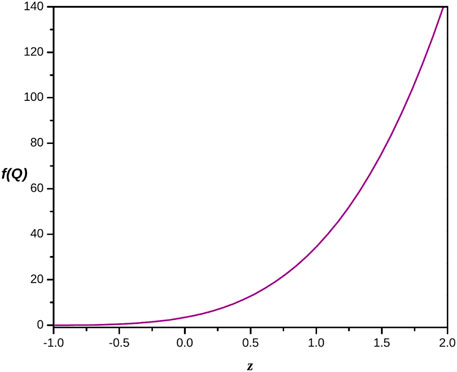
FIGURE 1. Plot of reconstructed ghost dark energy f(Q) gravity model versus redshift for the appropriate choice of constants c = 0.1 and c1 = 3.0.
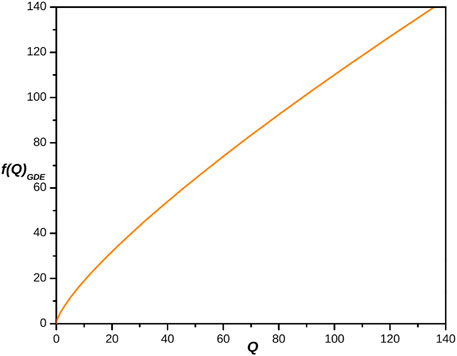
FIGURE 2. Plot of reconstructed ghost dark energy f(Q) gravity model versus non-metricity parameter for the appropriate choice of constants c = 0.1 and c1 = 3.0.
4.1 Cosmographic Observations in Reconstructed Ghost Dark Energy f(Q) Gravity Model
Using Eq. (39) in Eqs 33 and 34, the expression for energy density and pressure are obtained as:
The behavior of both pressure and energy density versus redshift of reconstructed ghost dark energy f(Q) gravity model is clearly shown in Figures 3, 4 respectively. Figure 4 depicted that the energy density of reconstructed ghost dark energy f(Q) gravity model is always positive and exponentially increases (see Figure 4) while pressure is always negative and shows negatively decreasing behaviour (see Figure 3) for all z = −1 to z > 0. Hence, such a behavior of pressure is the evidence of existance of dark energy.
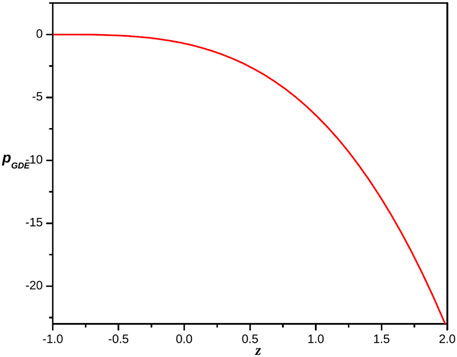
FIGURE 3. Plot of the pressure of the reconstructed ghost dark energy f(Q) gravity model versus redshift for the appropriate choice of constants.
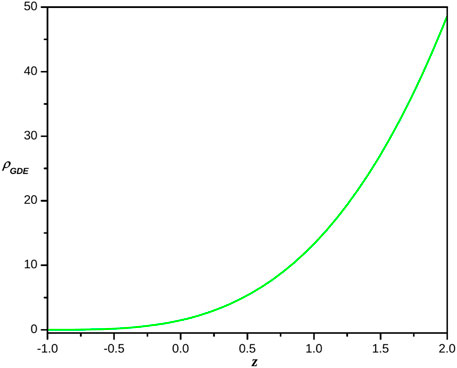
FIGURE 4. Plot of the energy density of the reconstructed ghost dark energy f(Q) gravity model versus redshift for the appropriate choice of constants.
4.1.1 Equation of State Parameter
Eq. (42) represents the expression for equation of state parameter of ghost dark energy f(Q) gravity model. Figure 5 represents the dynamical evolution of the equation of state parameter of ghost dark energy f(Q) gravity model for three consecutive values of η. One can see in Figure 5 that at late Universe (z < − 1) towords η = 0.10, 0.15 and 0.20 the value of equation of state parameter of ghost dark energy f(Q) gravity model is less than −1 i.e.
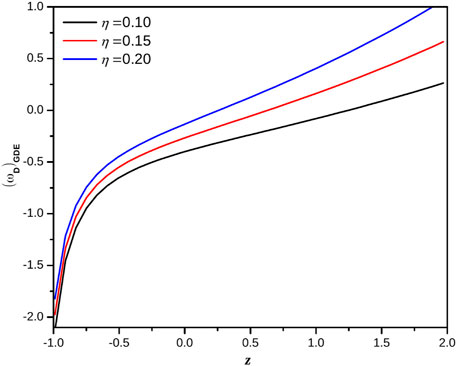
FIGURE 5. Plot of equation of state parameter of ghost dark energy f(Q) gravity model versus redshift for the appropriate choice of constants.
4.1.2
The derivative of Eq. (42) with respect to ℓn(a), gives
The plot of
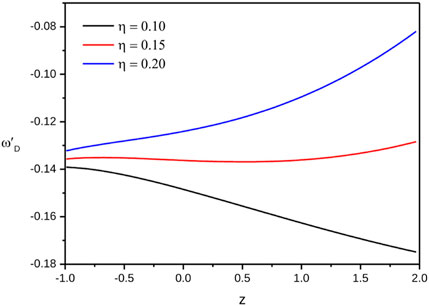
FIGURE 6. Plot of
4.1.3 (r−s)-plane
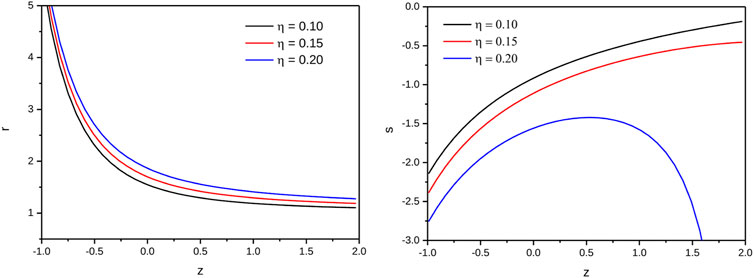
FIGURE 7. Plot of r and s of ghost dark energy f(Q) gravity model versus redshift for the appropriate choice of constants.
5 Reconstruction of Pilgrim Dark Energy f(Q) Gravity
Proceeding the same as it is in section 3. In this section, we reconstructed the pilgrim dark energy f(Q) gravity model.For this consider an interesting model for the description of dark energy is pilgrim dark energy in which the total energy in a box of size L could exceed the mass of a black hole of the same size i.e.,
the simplest way to set the above equation is:
where n and s are the conventional constant and pilgrim dark energy parameter respectively. Thus, from Eqs 46, 47,
Keeping the box of size L = 1/H towards Hubble’s cutoff, the dynamical pilgrim dark energy model whose energy density from Eq. (47) is obtained as
We establish the correspondence between pilgrim dark energy and f(Q) gravity model by equating the conforming densities. Using Eqs 33, 49, it follows that
The re-arrangement of above Eq. (50) provide
which is the first order linear differential equation in Q whose solution is of the form as
where
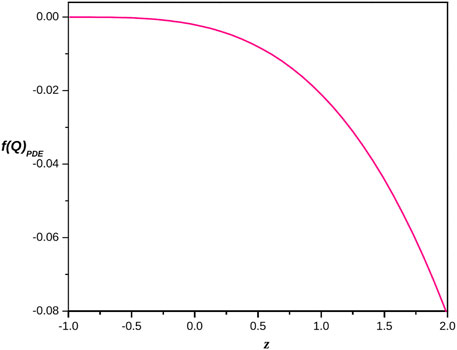
FIGURE 8. Plot of reconstructed pilgrim dark energy f(Q) gravity model versus redshift for the appropriate choice of constants c2 = 0.0018 and c3 = 0.1.
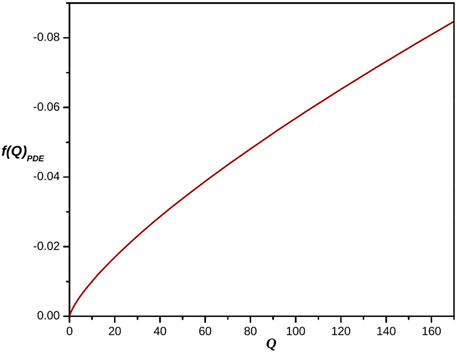
FIGURE 9. Plot of reconstructed pilgrim dark energy f(Q) gravity model versus non-metricity parameter for the appropriate choice of constants c2 = 0.0018 and c3 = 0.1.
5.1 Cosmographic Observations in Reconstructed Pilgrim Dark Energy f(Q) Gravity Model
Using Eq. (52) in Eqs 33 and 34, the expression for energy density and pressure are obtained as:
The behavior of both pressure and energy density versus redshift of reconstructed pilgrim dark energy f(Q) gravity model is clearly seen in Figures 10, 11 respectively. The energy density of reconstructed ghost dark energy f(Q) gravity model is always positive and exponentially increases (see Figure 11) whereas pressure is always negative and shows negatively decreasing behevior (see Figure 10) for all z = −1 to z > 0 which is the evidance of existance of dark energy.
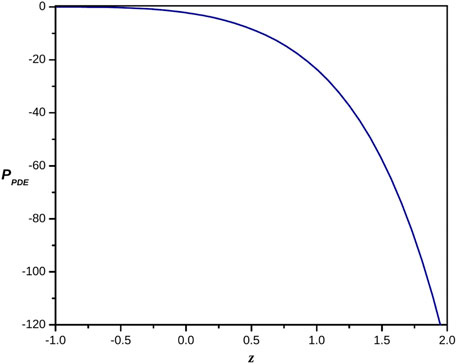
FIGURE 10. Plot of the pressure of the reconstructed pilgrim dark energy f(Q) gravity model versus redshift for the appropriate choice of constants.
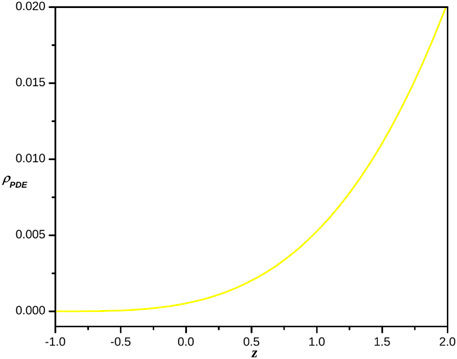
FIGURE 11. Plot of the energy density of the reconstructed pilgrim dark energy f(Q) gravity model versus redshift for the appropriate choice of constants.
5.1.1 Equation of State Parameter
Eq. (55) represents the expression for equation of state parameter of pilgrim dark energy f(Q) gravity model. Figure 12 represents the dynamical evolution of the equation of state parameter of pilgrim dark energy f(Q) gravity model for three consecutive values of η. One can see in Figure 12 that at late Universe (z < − 1) towords η = 0.10, 0.15 and 0.20 the value of equation of state parameter of pilgrim dark energy f(Q) gravity model is less than −1 i.e.,
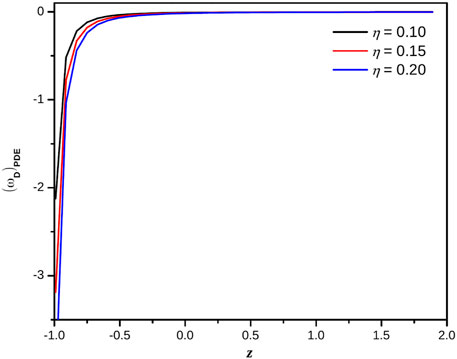
FIGURE 12. Plot of equation of state parameter of pilgrim dark energy f(Q) gravity model versus redshift for the appropriate choice of constants.
5.1.2
The plot of
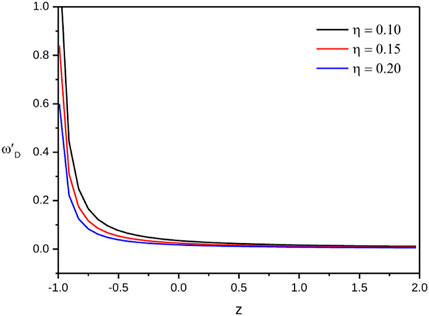
FIGURE 13. Plot of
5.1.3 (r−s)-plane
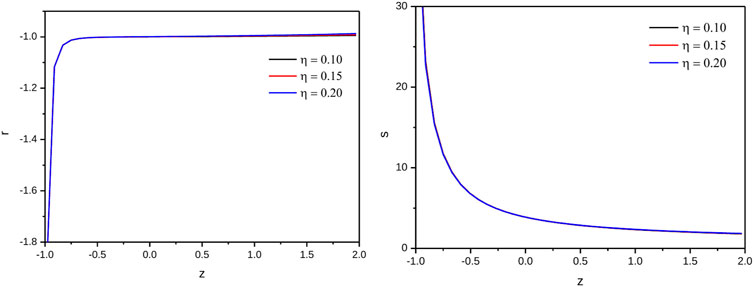
FIGURE 14. Plot of r and s of pilgrim dark energy f(Q) gravity model versus redshift for the appropriate choice of constants.
6 Conclusion
In the present analysis, to talk over the evolution of the Universe We have considered the interacting f(Q) gravity with pressureless matter in an FRW Universe via the reconstruction scheme with power-law form of the scale factor. For this purpose, we have used a newly proposed ghost and pilgrim dark energy model which has a strong repulsive force without a formation of black holes also these are the remarkable models that solves the recent cosmic acceleration problem. The Hubble horizon is taken as the IR cutoff, which provides reliable results with interaction. To establish the correspondence between ghost, pilgrim dark energy and f(Q) gravity model, the corresponding densities have been considered equal. The physical motivation and the consequence of considering this equality show whether the reconstructed model is a realistic one or not. Such methods i.e. equating two densities have been extensively studied in the literature on ghost and pilgrim dark energy in the framework of different modified gravities.To discuss the ghost and pilgrim dark energy f(Q) gravity models, We have explored the evolution trajectories of the equation of state parameter, the
6.1 Ghost Dark Energy f(Q) Gravity Model
(1) The reconstructed ghost dark energy f(Q) gravity model represents increasing behavior forever with respect to both z and Q which shows that the reconstructed model is a realistic one.
(2) The equation of state parameter represents the late Universe it involves phantom field dark energy while the present Universe consist of a quintessence field dark energy and early Universe involve barotropic fluid. Also, we should notice that with the different increasing value of interaction parameter η, equation of state parameter takes more negative values below the -1. Hence, our results are consistent with the current accelerated cosmic behavior and hence I conclude that the ghost dark energy f(Q) gravity model favors the dark energy phenomenon. The equation of state in our framework can crosses the phantom divide line as supported by recent astrophysical observations.
(3) The evolutionary behavior of the
(4) The corresponding trajectories of (r − s)-plane indicate Chaplygin gas model for all η. Furthermore, it attains CDM limit but cannot achieve ΛCDM limit.
6.2 Pilgrim Dark Energy f(Q) Gravity Model
(1) The reconstructed ghost dark energy f(Q) gravity model is always negative and decreases negatively with respect to both z and Q.
(2) The equation of state parameter at late Universe is less than -1 which represents the model involved phantom field dark energy which is the same as that of Ghost dark energy f(Q) gravity model whereas for present and early Universe it is a little bit upper than -1. Hence the present and early Universe consists of a quintessence field dark energy. Also, in the Pilgrim dark energy f(Q) gravity model, it is noticed that by increasing the value of interaction parameter η, equation of state takes more negative values, below the -1. It is observed that the equation of state in our framework can cross the phantom divide line as supported by recent astrophysical observations.
(3) The evolutionary behavior of the
(4) The corresponding trajectories of (r − s)- plane favor the quintessence field dark energy model for all η. Furthermore, it crosses ΛCDM limit.
Hence, the results obtained in both the reconstruction scheme under ghost and pilgrim dark energy are rusumbles with the recent modern theoretical observational data as well as the work analyzed by (sharf and Zuber, 2014; Jawad and Rani, 2015; Jawad et al., 2016a; Wu and Yu, 2006; Shafiz and Saba, 2019).
Data Availability Statement
The original contributions presented in the study are included in the article/supplementary material, further inquiries can be directed to the corresponding author.
Author Contributions
All of the authors listed have contributed a significant, direct, and intellectual contribution to the work and have given their permission for it to be published.
Funding
This research was funded by the Science Committee of the Ministry of Education and Science of the Republic of Kazakhstan (Grant No. AP09058240).
Conflict of Interest
The authors declare that the research was conducted in the absence of any commercial or financial relationships that could be construed as a potential conflict of interest.
Publisher’s Note
All claims expressed in this article are solely those of the authors and do not necessarily represent those of their affiliated organizations, or those of the publisher, the editors and the reviewers. Any product that may be evaluated in this article, or claim that may be made by its manufacturer, is not guaranteed or endorsed by the publisher.
Acknowledgments
The content of this manuscript has been presented in part at the “Two day International Virtual Conference on Recent Trends in Mathematical Sciences (IVCRTMS-2021)”, https://www.ijirmf.com/ivcrtms-oct-2021/. The authors are very much grateful to the honorary referee and the editor for the illuminating suggestions that have significantly improved our work in terms of research quality and presentation.
References
Abbas, G., Momeni, D., Aamir Ali, M., Myrzakulov, R., and Qaisar, S. (2015). Anisotropic Compact Stars in F(G) Gravity. Astrophys. Space Sci. 357, 158. doi:10.1007/s10509-015-2392-6
Aditya, Y., and Reddy, D. R. K. (2018). FRW Type Kaluza-Klein Modified Holographic Ricci Dark Energy Models in Brans-Dicke Theory of Gravitation. Eur. Phys. J. C 78, 619. doi:10.1140/epjc/s10052-018-6074-8
Azadi, A., Momeni, D., and Nouri-zonoz, M. (2008). Cylindrical Solutions in Metric F (R) Gravity. Phys. Lett. B 670, 210. doi:10.1016/j.physletb.2008.10.054
Bhatti, M. Z.-u. -H., Yousaf, Z., and Hanif, S. (2017). Role off(T)gravity on the Evolution of Collapsing Stellar Model. Phys. Dark Universe 16, 34–40. doi:10.1016/j.dark.2017.04.003
Bhoyar, S. R., Chirde, V. R., and Shekh, S. H. (2017). Stability of Accelerating Universe with Linear Equation of State in F (T) Gravity Using Hybrid Expansion Law. Astrophysics 60, 259–272. doi:10.1007/s10511-017-9480-y
Caldwell, R. R., and Linder, E. V. (2005). Limits of Quintessence. Phys. Rev. Lett. 95, 141301. doi:10.1103/physrevlett.95.141301
Capozziello, S., Stabile, A., and Troisi, A. (2007). Spherically Symmetric Solutions in F ( R ) Gravity via the Noether Symmetry Approach. Cl. Quantum Grav. 24, 2153–2166. doi:10.1088/0264-9381/24/8/013
Capozziello, S., Martin-Moruno, P., and Rubano, C. (2008). Dark Energy and Dust Matter Phases from an Exact F(R)-cosmology Model. Phys. Lett. Sect. B 664, 12. doi:10.1016/j.physletb.2008.04.061
Chirde, V. R., and Shekh, S. H. (2015). Dark Energy Cosmological Model in a Modified Theory of Gravity. Astrophysics 58, 106–119. doi:10.1007/s10511-015-9369-6
Chirde, V. R., and Shekh, S. H. (2016a). Isotropic Background for Interacting Two Fluid Scenario Coupled with Zero Mass Scalar Field in Modified Gravity. Bul. J. Phys. 43, 156.
Chirde, V. R., and Shekh, S. H. (2016b). Plane Symmetric Dark Energy Models in the Form of Wet Dark Fluid in F (R,T) Gravity. J. Astrophys. Astron. 37, 1–16. doi:10.1007/s12036-016-9391-z
Chirde, V. R., and Shekh, S. H. (2018a). Dynamic Minimally Interacting Holographic Dark Energy Cosmological Model in F(T) Gravity. Indian J. Phys. 92, 1485–1494. doi:10.1007/s12648-018-1236-y
Chirde, V. R., and Shekh, S. H. (2018b). Transition between General Relativity and Quantum Gravity Using Quark and Strange Quark Matter with Some Kinematical Test. J. Astrophys. Astron 39, 56. doi:10.1007/s12036-018-9555-0
Chirde, V. R., and Shekh, S. H. (2019). Dynamics of Magnetized Anisotropic Dark Energy in f(R, T) Gravity with Both Deceleration and Acceleration. Bulg. J. Phys. 46, 94.
Dagwal, V. J., and Pawar, D. D. (2020). Two-fluid Sources in F (T ) Theory of Gravity. Mod. Phys. Lett. A 35, 1950357. doi:10.1142/s0217732319503577
Daouda, M. H., Rodrigues, M. E., and Houndjo, M. J. S. (2012). Static Anisotropic Solutions in F(T) Theory. Eur. Phys. J. C 72, 1890. doi:10.1140/epjc/s10052-012-1890-8
Eisenstein, D. J. (2005). Detection of the Baryon Acoustic Peak in the Large-Scale Correlation Function of SDSS Luminous Red Galaxies. Astrophys. J. 633, 560. doi:10.1086/466512
Frusciante, N. (2021). Signatures of f(Q)-Gravity in Cosmology. Phys. Rev. D 103 (4), 044021. doi:10.1103/PhysRevD.103.044021
Harko, T., Lobo, F. S. N., Nojiri, S., and Odintsov, S. D. (2011). f(R,T) Gravity. Phys. Rev. D. 84, 1. doi:10.1103/physrevd.84.024020
Jain, B., and Taylor, A. (2003). Cross-Correlation Tomography: Measuring Dark Energy Evolution with Weak Lensing. Phys. Rev. Lett. 91, 141302. doi:10.1103/physrevlett.91.141302
Jawad, A., and Rani, S. (2015). Cosmological Evolution of Pilgrim Dark Energy in F(G) Gravity. Adv. High Energy Phys. 2015, 952156. doi:10.1155/2015/952156
Jawad, A., Debnath, U., and Batool, F. (2015). Generalized Ghost Pilgrim Scalar Field Models of Dark Energy. Commun. Theor. Phys. 64, 590–596. doi:10.1088/0253-6102/64/5/590
Jawad, A., Chattopadhyay, S., and Rani, S. (2016a). Viscous Pilgrim F ( T ) $F(T)$ Gravity Models. Astrophys. Space Sci. 361, 231. doi:10.1007/s10509-016-2814-0
Jawad, A., Rani, S., Salako, I. G., Gulshan, F., and Gulshan, F. (2016b). Aspects of Some New Versions of Pilgrim Dark Energy in DGP Braneworld. Eur. Phys. J. Plus 131, 236. doi:10.1140/epjp/i2016-16236-x
Jawad, A., Rani, S., Salako, I. G., and Gulshan, F. (2017). Pilgrim Dark Energy Models in Fractal Universe. Int. J. Mod. Phys. D. 26, 1750049. doi:10.1142/s0218271817500493
Jawad, A. (2015). Cosmological Analysis of Pilgrim Dark Energy in Loop Quantum Cosmology. Eur. Phys. J. C 75, 206. doi:10.1140/epjc/s10052-015-3430-9
Jimenez, J. B., Heisenberg, L., and Koivisto, T. (2018). Coincident General Relativity. Phys. Rev. D. 98, 044048. doi:10.1103/physrevd.98.044048
Kawarabayashi, K., and Ohta, N. (1980). The η Problem in the Large-N Limit: Effective Lagrangian Approach. Nucl. Phys. B 175, 477–492. doi:10.1016/0550-3213(80)90024-3
Kiran, M., Reddy, D. R. K., and Rao, V. U. M. (2015). Minimally Interacting Holographic Dark Energy Model in Brans-Dicke Theory. Astrophys. Space Sci. 356, 407–411. doi:10.1007/s10509-014-2213-3
Komatsu, E. (2011). Seven-year Wilkinson Microwave Anisotropy Probe (WMAP) Observations: Cosmological Interpretation. Astrophys. J. Suppl. 192, 18. doi:10.1088/0067-0049/192/2/18
Lazkoz, R. (2019). Observational Constraints of F(Q) Gravity. Phys. Rev. D. 100, 104027. doi:10.1103/PhysRevD.100.104027
Mandal, S., Sahoo, P. K., and Santos, J. R. L. (2020a). Energy Conditions in F (Q ) Gravity. Phys. Rev. D. 102, 024057. doi:10.1103/physrevd.102.024057
Mandal, S., Wang, D., and Sahoo, P. K. (2020b). Cosmography in F(Q) Gravity. Phys. Rev. D. 102, 124029. doi:10.1103/physrevd.102.124029
Naidu, R. L., Satyanarayana, B., and Reddy, D. R. K. (2012). LRS Bianchi Type-II Dark Energy Model in a Scalar-Tensor Theory of Gravitation. Astrophys. Space Sci. 338, 333–336. doi:10.1007/s10509-011-0935-z
Nath, P., and Arnowitt, R. (1981). U(1) Problem: Current Algebra and Theθvacuum. Phys. Rev. D. 23, 473–476. doi:10.1103/physrevd.23.473
Nojiri, S. i., and Odintsov, S. D. (2007). Modified Gravity and its Reconstruction from the Universe Expansion History. J. Phys. Conf. Ser. 66, 012005. doi:10.1088/1742-6596/66/1/012005
Nojiri, S., and Odintsov, S. (2008). Future Evolution and Finite-Time Singularities in F(R) Gravity Unifying Inflation and Cosmic Acceleration. Phys. Rev. D. 78, 046006. doi:10.1103/PhysRevD.78.046006
Pawar, D. D., Bhuttampalle, G. G., and Agrawal, P. K. (2018). Kaluza-Klein String Cosmological Model in f(R, T) Theory of Gravity. New Astron. 65, 1–6. doi:10.1016/j.newast.2018.05.002
Perlmutter, S. (1999). Measurements of Ω and Λ from 42 High-Redshift Supernovae. Astrophys. J. 517, 565. doi:10.1086/307221
Rani, S., Jawad, A., Ines, G., and SalakoAzhar, N. (2016). Non-Flat Pilgrim Dark Energy Frw Models in Modified Gravity. Astrophys. Space Sci. 361, 386. doi:10.1007/s10509-016-2868-z
Riess, A. G. (1998). Observational Evidence from Supernovae for an Accelerating Universe and a Cosmological Constant. Astron. J. 116, 1009. doi:10.1086/300499
Sadeghi, J., Khurshudyan, M., Movsisyan, A., and Farahani, H. (2013). Interacting Ghost Dark Energy Models with variableGand Λ. J. Cosmol. Astropart. Phys. 2013, 031. doi:10.1088/1475-7516/2013/12/031
Sahni, V., Saini, T. D., Starobinsky, A. A., and Alam, U. (2003). Statefinder-A New Geometrical Diagnostic of Dark Energy. Jetp Lett. 77, 201–206. doi:10.1134/1.1574831
Sahoo, P. K., and Bhattacharjee, S. (2020). Revisiting the Coincidence Problem in F(R) Gravitation. New Astron. 77, 101351. doi:10.1016/j.newast.2019.101351
Sahoo, P. K., Mishra, B., and Chakradhar, R. (2014). Axially Symmetric Cosmological Model in f(R, T) Gravity. Eur. Phys. J. Plus. 129, 1. doi:10.1140/epjp/i2014-14049-7
Santhi, M. V., Rao, V. U. M., and Aditya, Y. (2017). Bianchi type-VI0 Modified Holographic Ricci Dark Energy Model in a Scalar-Tensor Theory. Can. J. Phys. 95, 179–183. doi:10.1139/cjp-2016-0628
Sarkar, S., and Mahanta, C. R. (2013). Holographic Dark Energy Model with Quintessence in Bianchi Type-I Space-Time. Int. J. Theor. Phys. 52, 1482–1489. doi:10.1007/s10773-012-1468-0
Seljak, U. (2005). Cosmological Parameter Analysis Including SDSS Ly α Forest and Galaxy Bias: Constraints on the Primordial Spectrum of Fluctuations, Neutrino Mass, and Dark Energy. Phys. Rev. D. 71, 103515. doi:10.1103/PhysRevD.71.103515
Sharif, M., and Fatima, H. I. (2016). Built-in Inflation in F(G) Gravity. Int. J. Mod. Phys. D. 25, 1650011. doi:10.1142/s0218271816500115
Sharif, M., and Jawad, A. (2013). Pilgrim Dark Energy with Apparent and Event Horizons in Non-flat Universe. Eur. Phys. J. C 73, 2600. doi:10.1140/epjc/s10052-013-2600-x
Sharif, M., and Yousaf, Z. (2013). Dynamical Instability of the Charged Expansion-free Spherical Collapse in F(R) Gravity. Phys. Rev. D. 88, 024020. doi:10.1103/physrevd.88.024020
Sharif, M., and Zubair, M. (2014). Cosmological Evolution of Pilgrim Dark Energy. Astrophys. Space Sci. 352, 263–272. doi:10.1007/s10509-014-1889-8
Sharif, M., and Saba, S. (2018). Pilgrim Dark Energy in f(G, T) Gravity. Mod. Phys. Lett. A 33, 1850182. doi:10.1142/s0217732318501821
Sharif, M., and Saba, S. (2019). Ghost Dark Energy Model in f(G) Gravity. Chin. J. Phys. 58, 202–211. doi:10.1016/j.cjph.2018.12.023
Shekh, S. H., and Chirde, V. R. (2019). Analysis of General Relativistic Hydrodynamic Cosmological Models with Stability Factor in Theories of Gravitation. Gen. Relativ. Gravit. 51, 87. doi:10.1007/s10714-019-2565-7
Shekh, S. H., and Chirde, V. R. (2020). Accelerating Bianchi Type Dark Energy Cosmological Model with Cosmic String in $F(T)$ Gravity. Astrophys. Space Sci. 365, 60. doi:10.1007/s10509-020-03772-y
Shekh, S. H., Arora, S., Chirde, V. R., and Sahoo, P. K. (2020a). Thermodynamical Aspects of Relativistic Hydrodynamics in f(R,G) Gravity. Int. J. Geom. Methods Mod. Phys. 17, 2050048. doi:10.1142/s0219887820500486
Shekh, S. H., Chirde, V. R., and Sahoo, P. K. (2020b). Energy Conditions of the f(T, B) Gravity Dark Energy Model with the Validity of Thermodynamics. Commun. Theor. Phys. 72, 085402. doi:10.1088/1572-9494/ab95fd
Shekh, S. H., Katore, S. D., Chirde, V. R., and Raut, S. V. (2021). Signature Flipping of Isotropic Homogeneous Space-Time with Holographic Dark Energy in f(G)gravity. New Astron. 84, 101535. doi:10.1016/j.newast.2020.101535
Shekh, S. H. (2021a). Models of Holographic Dark Energy in F(Q) Gravity. Phys. Dark Universe 33, 100850. doi:10.1016/j.dark.2021.100850
Shekh, S. H. (2021b). Dynamical Analysis with Thermodynamic Aspects of Anisotropic Dark Energy Bounce Cosmological Model in f(R, G) Gravity. New Astron. 83, 101464. doi:10.1016/j.newast.2020.101464
Sheykhi, A., and Movahed, M. S. (2012). Interacting Ghost Dark Energy in Non-flat Universe. Gen. Relativ. Gravit. 44, 449–465. doi:10.1007/s10714-011-1286-3
Spergel, D. N. (2003). First-Year Wilkinson Microwave Anisotropy Probe (WMAP)* Observations: Determination of Cosmological Parameters. Astrophys. J. Suppl. 148, 175. doi:10.1086/377226
Tegmark, M. (2004). Cosmological Parameters from SDSS and WMAP. Phys. Rev. D. 69, 103501. doi:10.1103/PhysRevD.69.103501
Wei, H., Qi, H.-Y., and Ma, X.-P. (2012). Constraining F(T) Theories with the Varying Gravitational Constant. Eur. Phys. J. C 72, 2117. doi:10.1140/epjc/s10052-012-2117-8
Witten, E. (1979). Current Algebra Theorems for the U(1) "Goldstone Boson". Nucl. Phys. B 156, 269–283. doi:10.1016/0550-3213(79)90031-2
Wu, P., and Yu, H. (2006). Statefinder Parameters for Phantom Dark Energy. Mod. Phys. Lett. A 21, 1305–1311. doi:10.1142/s0217732306019293
Keywords: cosmological evolution, f (Q) gravity, isotropic homogeneous space-time, non-metricity scalar, ghost dark energy, pilgrim dark energy
Citation: Myrzakulov N, Shekh SH, Mussatayeva A and Koussour M (2022) Analysis of Reconstructed Modified Symmetric Teleparallel f(Q) Gravity. Front. Astron. Space Sci. 9:902552. doi: 10.3389/fspas.2022.902552
Received: 23 March 2022; Accepted: 21 April 2022;
Published: 04 July 2022.
Edited by:
Kazuharu Bamba, Fukushima University, JapanReviewed by:
Abdul Jawad, COMSATS University Islamabad, PakistanVyacheslav Ivanovich Dokuchaev, Institute for Nuclear Research (RAS), Russia
Copyright © 2022 Myrzakulov, Shekh, Mussatayeva and Koussour. This is an open-access article distributed under the terms of the Creative Commons Attribution License (CC BY). The use, distribution or reproduction in other forums is permitted, provided the original author(s) and the copyright owner(s) are credited and that the original publication in this journal is cited, in accordance with accepted academic practice. No use, distribution or reproduction is permitted which does not comply with these terms.
*Correspondence: N. Myrzakulov, bm15cnpha3Vsb3ZAZ21haWwuY29t
 N. Myrzakulov
N. Myrzakulov S. H. Shekh
S. H. Shekh A. Mussatayeva1,4
A. Mussatayeva1,4